MSI GT70 Review: GTX 880M Edition
by Jarred Walton on April 16, 2014 6:00 AM ESTBattery Life
We’ve already covered the gaming aspect of battery life and Battery Boost, but we still haven’t properly addressed “normal” battery life. We ran our two standard tests for battery life; the Light workload simulates constant web surfing by loading four pages every minute until the battery is drained, while the Heavy workload loads the same four pages every 10 seconds while downloading (via Filezilla from a local PC) a constant 8Mbps stream of data and playing back a 1080p MP4 H.264 movie. We have switched to using the Video app on Windows 8, so our updated Heavy workload tends to get better battery life than our previous setup, but the results are at least moderately comparable.
For all of our battery life tests, we optimize the power profile and software to deliver what should be a best-case result. This includes disabling/uninstalling any firewall or anti-virus software, turning off other extraneous utilities that are not needed (e.g. Live Updates), and we use the Power Saver profile. We find a brightness setting as close as possible to 200 nits (cd/m2), set the minimum CPU performance to 0% and the maximum to 100%, disable screen dimming or powering off, and disable sleep/hibernate modes. The HDD/SSD is set to power off after 1 minute of inactivity, and the WiFi is set to maximum power savings. Here are our results.
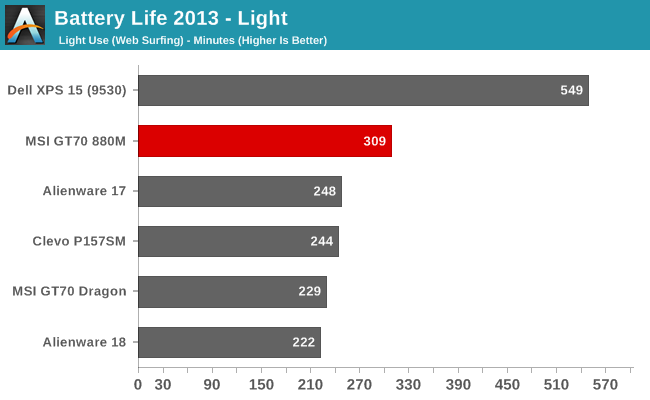
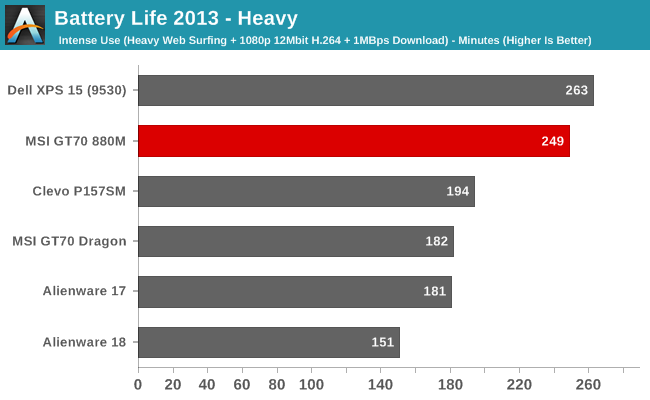

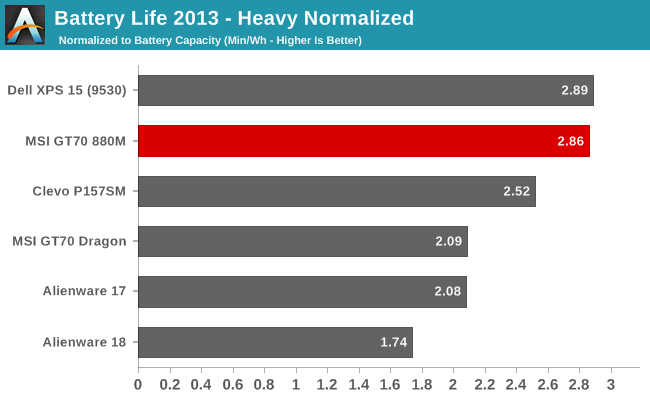
The updated GT70 shows a nice improvement in battery life compared to the previous model, though it should be noted that BIOS updates to the earlier GT70 Dragon did help as well. Perhaps even more impressive is the result in our Heavy workload, though at least some of the difference is due to the change in video playback software and the movie we use for testing. The Dell XPS 15 is the only other notebook in our charts to use the same file/player, and interestingly it’s only slightly ahead of the MSI GT70 (compared to easily surpassing it in the Light test). It looks like the GT70 is better optimized for performance over battery life in lighter loads, and while five hours of useful battery life won’t make it through an entire day for most people, it’s at least enough that you won’t need to pull out an AC adapter during a typical domestic flight. Unless you’re gaming, in which case you can expect closer to 1-1.5 hours, even with Battery Boost enabled; that’s the price of a high performance gaming notebook.
Temperatures and Noise
Running a “worst-case” 100% CPU+GPU workload, the GT70 does get quite toasty, but we’ve seen worse. Typical gaming temperatures (i.e. without loading all the CPU cores as well) run about 10C lower on the CPU and a 5-10C cooler on the GPU, and pure CPU loads are not really a concern at all. I’d be a hesitant to try running a fully loaded GT70 24/7, but for normal use where you’d only hit the system hard for a few minutes at a time, MSI’s GT70 should suffice. Even in our full stress-test workload, the CPU cores never dropped below 3.1GHz. The GPU dropped a bit lower – 875MHz – but this is really an atypical workload on both the CPU and GPU. If we turn off our GPU load and replace it with a game, the clocks don’t drop below 950MHz (at least, not that we’ve seen).
As for noise levels, not much has changed since our last look. At maximum load the GT70 fan generates 51.5dB from 18”, which is very loud – in fact, I’m pretty sure it has the dubious distinction of being the loudest notebook we’ve ever tested. This is really the major complaint we have with the single fan cooling arrangement. Games do tend to be a bit quieter (45dB), but if you're in a warmer environment you'll likely hear the full speed fan kick in.
The temperatures may or may not be “too high”, depending on whom you ask, but when other gaming notebooks never get above 45dB – and notebooks like the ASUS G750JH stay under 40dB – the GT70 makes a statement in a way that’s likely to turn heads with people wondering, “who turned on the blow dryer!?” Other notebook manufacturers have shown that it’s possible to put two largish fans into a 17” gaming chassis, so it’s not a matter of it being too difficult; instead, it appears MSI is simply content to stick with their several years old design, and perhaps pass along some of the cost savings to the users.


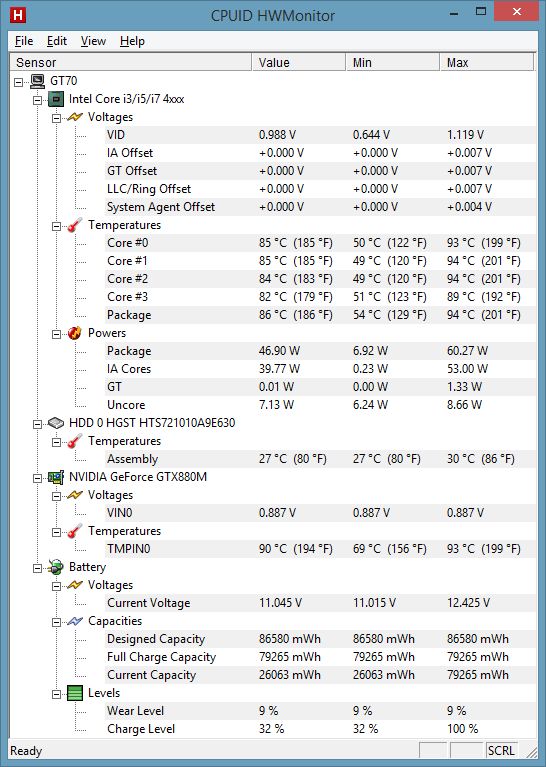
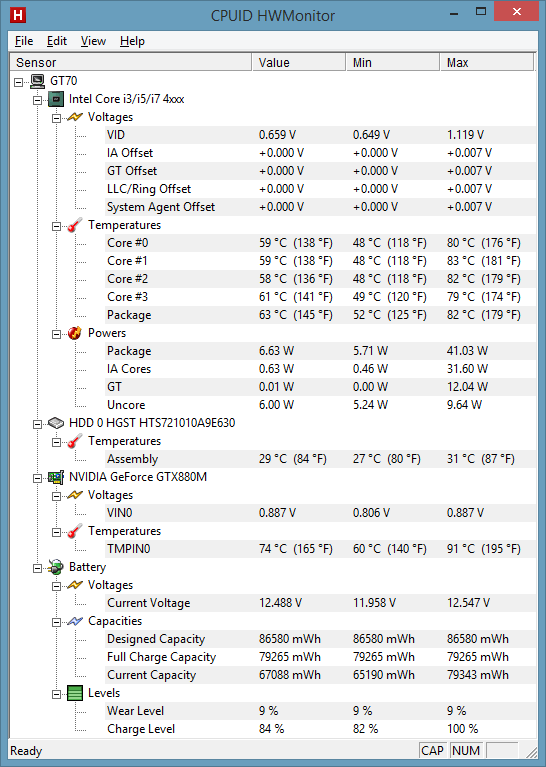








61 Comments
View All Comments
DanNeely - Thursday, April 17, 2014 - link
I have to disagree. The faster startup is nice; but it's the smoother response in ordinary use that's really sold me. Moving my OS/Apps to an SSD a few years ago did more to improve general system responsiveness than any upgrade I've made other than my initial move from a single to a dual core CPU.Notmyusualid - Monday, April 28, 2014 - link
I get chest-pains waiting on mechanical hard disks when used as a boot disk...My mother, and two of my brothers have switched over to SSDs, (at great effort by me), and they say they could never go back / transformed their machine etc. The third brother is too cheap to do so.
Now if you have the premium of time on your side, sure hitting the power button, and fetching coffee is fine.
But as a network engineer under the gun, when you have strict site-access periods, and it takes 2 weeks to get your access, and during your line-up testing, your in-house application crashes, and you've got only 30 mins before your escorted access ends, it is a God-send to be able to reboot quickly, start the database, and get your application up again, and continue to work with the other end of the link... I've known Core 2 Duo laptops, with mechanical disks, take 8 to 10 mins to do that task I just described. One minute thereabouts (honestly) with SSD. Marvelous. Surprised me too.
You can hear the deep breaths from the other end when you say 'sorry I have to reboot', but not a problem for me for a few years now...
So sorry, cannot agree there is little difference.
jak3676 - Wednesday, April 16, 2014 - link
Am I the only one that read the headline and was wondering why in the world someone would put an 8 year old 8800 GTX in a laptop?huaxshin - Wednesday, April 16, 2014 - link
@JarredWalton:From the summary, you wrote GK110 instead of GK104.
"As far as NVIDIA’s new GTX 880M, performance is pretty much what you’d expect from a slightly higher clocked GK110"
-----------------------------------------------------------------
Also did you notice that this particular model did much better than your previous GT70 review in terms of thermals? With the Dragon Edition you and me had a little discussion regarding the temperatures. You got 98C with that one while here you get 82C.
Any thoughts to why?
JarredWalton - Wednesday, April 16, 2014 - link
Possibly just a difference in components -- some 780M may run hotter (and with higher voltages) than this 880M. I pushed the system as hard as I could, just to see if it would throttle. Anyway, Dustin tested the earlier Dragon, so I don't know if he just had a poor unit or what. And I'll go edit that GK110 error. LOL -- GK110 in a notebook, I wish!shatteredx - Wednesday, April 16, 2014 - link
No 120hz display kills it for me. Does MSI even have any models with a 120hz display?Antronman - Wednesday, April 16, 2014 - link
Why would they?It's not like an 880m will reach 120fps in any games.
shatteredx - Thursday, April 17, 2014 - link
Any FPS above 60 will be smoother on a 120hz display.Also, I play many older games that hit 120 fps even on my 680M.
erple2 - Friday, April 18, 2014 - link
You need a couple of qualifiers on that. If you play with vsync on, it won't be any smoother. If you play with triple buffering, it will. Personally, I play with vsync on as I dislike tearing more than frame drops (though with proper triple buffering, you don't get the integer scaling in fps with no lag like d3d buffering offers). Though this seems like a great case for the highly proprietary g-sync..nathanddrews - Thursday, April 17, 2014 - link
Maybe not with all eye-candy maxed out, but that's not really the point of 120fps gaming.